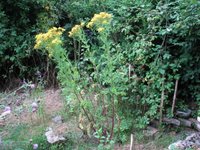
Today (31 July) was hay-cutting day for Mice & Red but I was busy and out a lot and I forgot. No matter, I will go for it on 1 August.
I did make a brief evening visit and simply sat there and enjoyed the relative coolness; enjoyed watching a rosy-flounced tabby, nectaring with evident satisfaction on flowers of ragwort. These attractive little pyralid moths, Endotricha flammealis, have been much in evidence this year.
July we learn has been the hottest month on record in Britain since records began in 1914 with an average day and night temperature of 17.8°C. The main effect this seems to have had in M3 is that some of the July flowers are going over to seed more quickly. This, of course, may be because there has been an almost continuous opportunity in the daytime for insect pollination rather than the heat per se.
I have bought a simple rain gauge and have set it up near M3 to see how much rain we actually do get. On this last day of July we did have a heavy shower at about 8pm and there was more rain overnight: it won’t fill the reservoirs, but it might help some of the plants along.
No comments:
Post a Comment